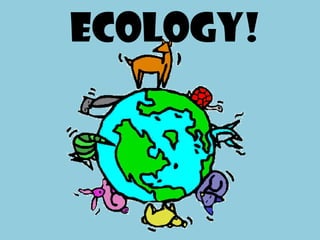Report
Share

More Related Content
Viewers also liked
Viewers also liked (19)
Chapter 21 Ecology Lesson 1 - Biotic and abiotic factors

Chapter 21 Ecology Lesson 1 - Biotic and abiotic factors
More from careng9
More from careng9 (18)
Biotic abiotic factors
- 1. Ecology!
- 2. Ecology is… • The study of interactions among organisms and their environments. What do you think???... How many different species exist on earth?? 1.6 Million!!!!
- 3. We break everything on earth into 2 categories… Biotic Abiotic Living Not-Living
- 5. In your notebook… 1- Brainstorm a list of at least 4 abiotic factors that and 4 biotic factors that exist. 2- Finish your pond ecosystem by answering the questions and coloring the parts of the pond that are designated. 3- Design your own ecosystem. Draw a picture of a specific ecosystem. Label the biotic and abiotic factors in your system. You must have at least 5 biotic and 3 abiotic.